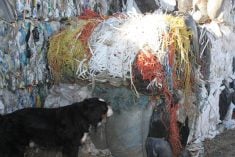For three years before the 2001 growing season, trials of genetically modified wheat were done with a buffer zone only 10 percent of what is now recommended.
The trials at seven of Agriculture Canada’s research farms in Western Canada used a three metre gap between the GM crops and other test plots. The buffer now is 30 m.
However, a researcher says the chances that non GM crops were
affected are minimal.
University of Saskatchewan cereal breeder Pierre Hucl said the chance of contamination of other cereal crops by pollen flow from small sources such as research plots is “really, really low.”
Read Also

Message to provincial agriculture ministers: focus on international trade
International trade stakeholders said securing markets in the face of increasing protectionism should be the key priority for Canada’s agriculture ministers.
He said that a large number of factors affect pollen and that pollen flow would be an unlikely contributor to GM contamination, even at commercially grown levels.
In 1999, federal research scientists decided the level of concern about pollen contamination of non-GM seed stocks by Monsanto’s Roundup Ready wheat was high enough to warrant new rules.
Concerns by the Canadian Wheat Board and farmers prompted an expanded isolation zone for 2000 and 30 m remains the Canadian Food Inspection Agency standard.
“We wanted to be doubly sure that we reduced the risk of gene escapes,” said Jim Bole, director of the federal Cereal Research Centre in Winnipeg.
“We have to admit the level of concern about the effect of a single GM kernel showing up in a boatload of wheat in Europe, and the effect that would have on international markets, helped push this decision.”
Bole, who helped establish the new procedures, said that as a further precaution, GM research at the Indian Head, Sask., facility was halted after 2000 because it does a lot of breeder and pedigreed seed development.
Bole said that hard red spring wheat varieties, of which the Roundup Ready research crop is one, are self-pollinating and as a result, the rate of gene out-crossing is very small.
Trish Jordan of Monsanto said the company was following CFIA guidelines “prior to the change in 2000 and we continue to follow them today.”
She said all the seed at Indian Head in 2000 was tested for the presence of the GM variety and none was found.
“Ag Canada decided we needed another site, away from the breeder seed, so we moved,” Jordan said.
This spring, Monsanto will grow Roundup Ready wheat at 29 locations, on a total of 18 acres of land in Western Canada, down slightly from 33 locations in 2002.














